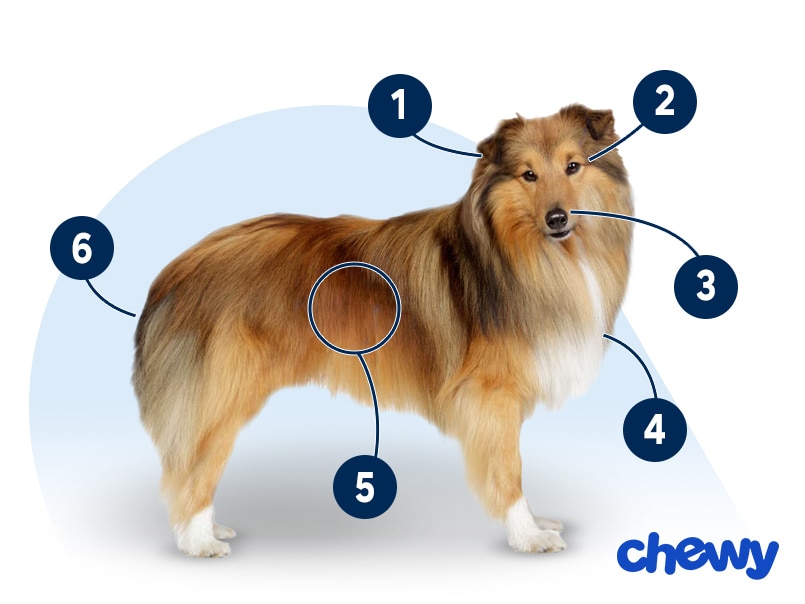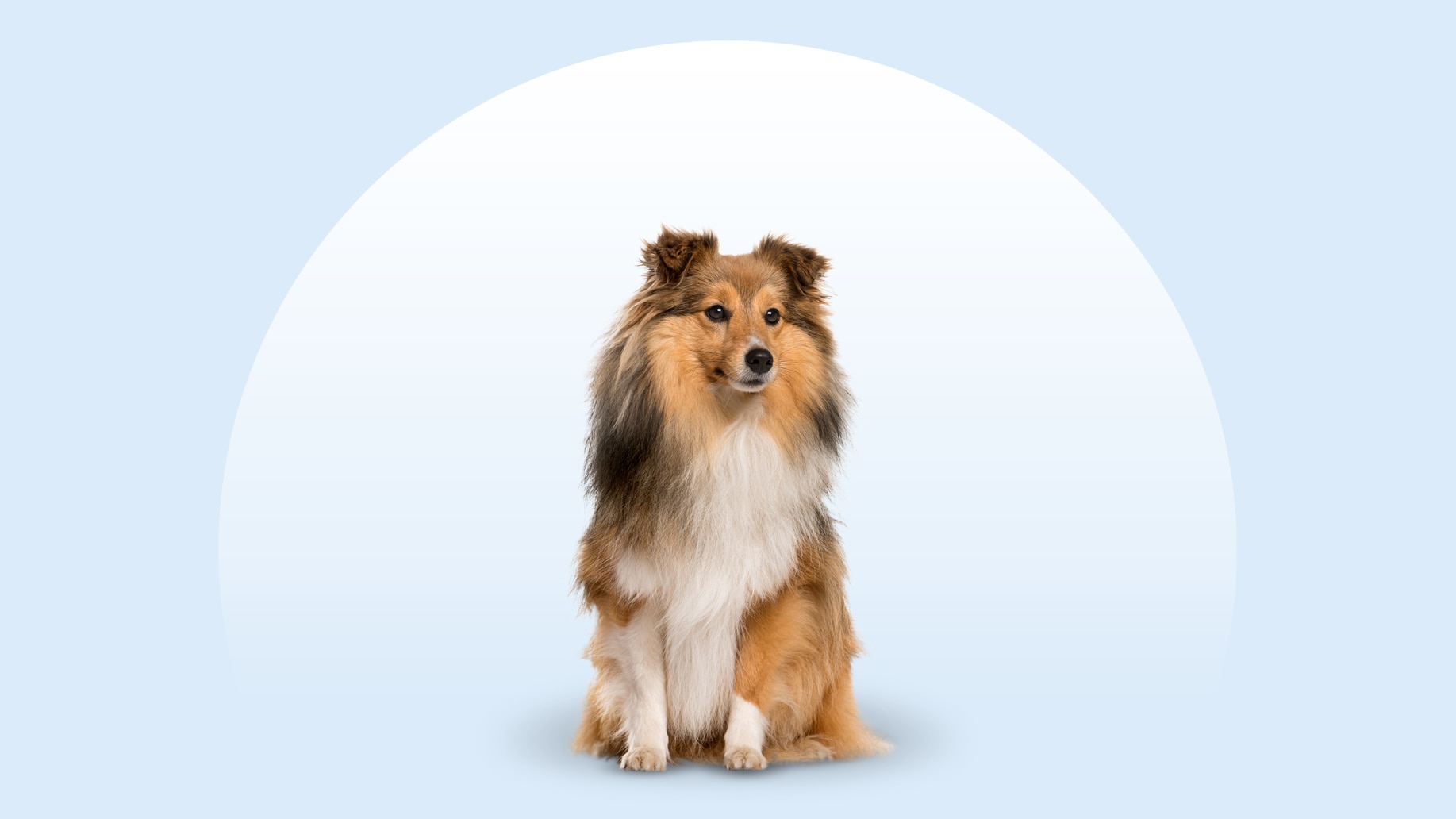Shetland Sheepdog
Updated October 31, 2025
Shetland Sheepdog
Updated October 31, 2025
Shetland Sheepdogs are energetic, affectionate, and perfect for pet parents who can provide plenty of training and grooming, thanks to that gorgeous double coat. But once you’re done brushing, you can get back to playtime! They’re always up for a game of fetch followed by a snuggle session.
Energetic, Friendly, Playful
15–25 pounds
13–16 inches
12–14 years
Sable and White, Black White and Tan, Blue Merle White and Tan, Blue Merle and White, Black and White, Sable Merle and White
The Shetland Sheepdog is a high-energy, sweet-natured breed who has it all—brains, beauty, and brawn. They excel at everything they do, whether it’s playing fetch, running agility courses, working as herders or therapy dogs, and—of course—stealing your heart.
If you’re looking for an adventurous, happy, affectionate bestie, a Shetland Sheepdog (or Sheltie, as they’re often called) might be your perfect dog.
Shetland Sheepdog Characteristics
Shetland Sheepdog Appearance
The Shetland Sheepdog looks like a rough-coated Collie, but on a smaller scale (the typical Sheltie size is just 15–25 pounds, while Collies can weigh up to 75 pounds).

- Ears
The Shetland Sheepdog’s ears are high-set and perky, but the tips tend to fold forward a bit.
- Eyes
The Sheltie’s almond-shaped eyes are usually dark brown, but blue merle Shelties may have blue eyes.
- Nose
Their nose is black and at the end of a long snout.
- Coat Length
The Sheltie has a double coat, with a dense undercoat that makes the dog's fur appear to stand out from the body. The outer coat is long and straight, and it’s particularly heavy around the head, hind legs, and tail.
- Coat Color
Sheltie colors include black, blue merle, and sable. Their coats typically have white and tan markings.
- Tail
Shelties have feathery tails with long fur. They carry their tail down or raised when alert, but their tail doesn’t curl over their back.
Shetland Sheepdog Temperament
The Sheltie dog breed is affectionate and easygoing. This pup just wants to play and make you happy. What’s more, they tend to get along with everyone, whether two- or four-legged. Because of the Shetland Sheepdog’s personality, they make great family dogs.
Despite their friendliness, Shelties might be reserved around strangers at first. But once they learn to trust them, they’re all in.
And while Sheltie dogs don’t have the athletic prowess of an Australian Shepherd, they’re still energetic and need an hour of exercise every day. They enjoy play and expending their energy, and they’ll love games that involve their favorite people.
They’re one of the smartest dog breeds, too, so Shelties need to stay busy with intellectual games like fun puzzle toys or nose work. Keeping them mentally stimulated is a must.
How to Care for a Shetland Sheepdog
Shetland Sheepdogs are a balance of low- and high-maintenance.
On the one hand, while they need daily walks and playtime, they don’t require intense amounts of heart-pounding exercise every day, like Border Collies do. But on the other hand, their grooming needs can be demanding, as their double coat needs regular brushing.
Grooming
Training
Diet
Exercise
Environment
Shetland Sheepdog Health
The average Shetland Sheepdog life expectancy is 12–14 years. They’re susceptible to a handful of medical issues, so pet insurance is a smart investment for the breed.
- Bladder cancer: Shelties have an increased risk of bladder cancer; in fact, they’re more likely to develop it than other breeds. Increased urination and/or blood in the urine is often the first symptom. Treatment may include surgery, radiation, or chemotherapy.
- Deafness: Deafness can occur in one or both ears. There’s no treatment for congenital deafness, but most dogs acclimate well to the condition and lead a full, happy life.
- Dermatomyositis: Dermatomyositis in dogs is a genetic autoimmune disorder that may present as skin lesions and muscle inflammation. There’s no cure, but your vet may suggest avoiding UV exposure and activities that damage the skin and muscles.
- Epilepsy: Shetland Sheepdogs are prone to seizures caused by epilepsy, which typically begins in dogs between 6 months and 5 years old. It’s treated with medication.
- Eye issues: Shelties are prone to a few genetic eye abnormalities:
- Collie eye anomaly (CEA) causes a dysfunction in the retina and can lead to blindness.
- Corneal dystrophy causes cloudiness in the outer layer of the eye; it’s inherited and does not always require treatment.
- Optic nerve hypoplasia is when the optical nerve doesn’t develop properly.
- Progressive retinal atrophy (PRA) leads to blindness in dogs. While there’s no cure, pups who lose their eyesight tend to adapt well and can still live full, happy lives.
- Hip dysplasia: Hip dysplasia is when the hip joint doesn’t form properly, leading to looseness, pain, and arthritis. It’s an inherited condition that can be made worse if a pup is overweight. More severe cases may require surgery, but the condition is often treated with medications, joint supplements, special diets, weight management, and/or physical therapy.
- Hypothyroidism: Common in Shetland Sheepdogs, hypothyroidism includes symptoms like lethargy, hair loss, ear and skin infections, and weight gain. A blood test can diagnose it, and treatment is a daily oral medication.
- Lupus: Shelties are prone to lupus in dogs. Symptoms vary but tend to include lesions on the face, enlarged lymph nodes, and seizures. If your dog has this disorder, you’ll want to keep them out of the sun. Treatment may include immunosuppressants or other medications.
- Multidrug resistance mutation (MDR1): MDR1 is a genetic condition that makes dogs more prone to serious side effects of certain medications.
- Patent ductus arteriosus (PDA): PDA is a congenital heart defect in dogs. It’s when a blood vessel near the heart doesn’t completely close after birth, and it can lead to heart failure. A heart murmur is usually the first sign, and the condition can often be corrected with surgery.
- Von Willebrand disease: Shelties are susceptible to von Willebrand disease, a bleeding disorder where the blood doesn’t clot properly. Your veterinarian can test your dog for this and give you tips for management.
Shetland Sheepdog History
The Shetland Sheepdog originated in (surprise) the Shetland Islands in the U.K., where the dogs worked as agile herders for sheep, chickens, and ponies. Shelties were also sometimes guardian dogs who helped to alert their human families to danger by barking.
There’s some uncertainty about whether Shelties are related to Collies. Some experts think that Shelties are descendants of Collies, while others say they just share a common ancestor in the Border Collie.
Shelties were first recognized by the Kennel Club in England as the Shetland Collie in 1909, and their name was changed that same year to Shetland Sheepdog. The first Shetland Sheepdog was registered by the American Kennel Club in 1911.
Shetland Sheepdog puppies can cost thousands of dollars. If you choose this route, pick a responsible breeder.
You can also adopt a Shetland Sheepdog, as there are many of these deserving pups waiting for their forever homes. Check out a local Shetland Sheepdog rescue like the Shetland Sheepdog Placement Services of New Jersey, keep an eye out at your local shelter, or search Chewy’s database of adoptable dogs in your area.








